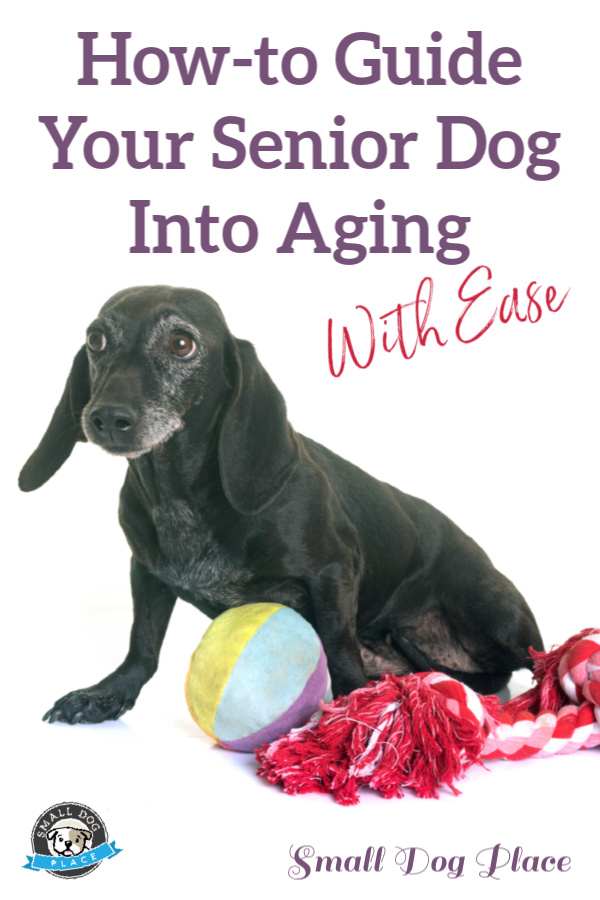- Small Dog Place Home
- Health
- Senior Dog Health
How-to Guide Your Senior Dog Into Aging with Ease: Safety, Health, Diet
Senior Dog by Frankie Wallace |Updated 03-24-2024
As your dog ages, you may notice some changes in his body and behavior. Those little grey hairs around his muzzle will become more plentiful, and he may lack the spring in his step that he had when he was younger.
 Greying around the muzzle is a sign of aging in many dog breeds.
Greying around the muzzle is a sign of aging in many dog breeds.He may take more and longer naps, and he may even develop some chronic health conditions. When it comes to aging dogs, this is all normal, and as your dog moves into his senior years, things will continue to change.
By changing your care routine, you can support your dog’s changing needs. You can work to give your dog some quality golden years, enjoying the time that you have with him and ensuring that he’s comfortable and happy during this time.
Some older dogs experience the typical problems associated with old age. Senior dog health care should be a priority to keep your dog comfortable and happy in his later years.
Keep Your Senior Dog Active
As your dog ages, he’ll probably naturally slow down his activity level a bit and may start taking more extended, more frequent naps. That’s normal for an aging dog, but it’s important to keep your dog as active as he’d like to be.
Regular exercise can help to fight off obesity in your senior pet, and it also provides entertainment, socialization opportunities, and fun.
While keeping your dog active is important, let him be the judge of how much activity is enough. Your dog may let you know that it’s time to scale back the length or intensity of your walks, and he may start to prefer shorter fetch sessions with a short break in between each throw.
Watch your dog for signs of fatigue and adjust your exercise and activity to suit his changing needs as he ages.
Preserve Eye Health
 Eye problems are relatively common in older dogs and cataracts are one example.
Eye problems are relatively common in older dogs and cataracts are one example.Eye health can naturally decline as pets age, but you can help to preserve your dog’s eye health. Just like humans, dogs’ eyes can be damaged by repeated exposure to UV rays from the sun. These rays can damage the lens, cornea, and retina of an eye, leaving your dog with lasting damage.
Because this damage is usually caused by prolonged UV ray exposure, it’s safe to take your dog outside for walks and potty breaks, but you should avoid leaving your dog outside to lounge in the sun for long periods.
Humans can protect their eyes from UV rays by wearing UV blocking contact lenses, but in the case of your dog, it’s best just to avoid unnecessary sun exposure.
Some older dogs develop cataracts or dry eye, both of which are treatable. While most dogs with limited vision do quite fine, it is still better to preserve vision where possible. Always check with your veterinarian if you suspect your dog injured his eye and have both eyes checked during your yearly office visit.
Work to Relieve Pain
 Providing pain management for your senior dog will help him stay active.
Providing pain management for your senior dog will help him stay active.There are many ways to care for your senior dog, but one of the most essential tasks that you may find yourself facing is helping to relieve your dog’s pain.
Alternative therapies like hydrotherapy, acupuncture, and physical therapy may all help with pain relief caused by physical issues, injuries, and just the effects of aging.
It’s always best to find the source of your dog’s pain and treat that cause, though that isn’t always possible, and sometimes pain in pets remains a bit of a mystery.
Depending on the cause of your dog’s pain, your vet may also be able to prescribe some medication to help with pain management.
CBD oil may also help with chronic pain management in pets, and some companies have even produced treats that are safe for your dog to ingest. These treats can make administering CBD oil easier and more enjoyable for both you and your dog.
Other over-the-counter supplements may also help with pain and stiffness. Chondroitin and Glucosamine are two ingredients often found together in products.
Chrondroitin is found in meat gristle and beef cartilage, but supplements have higher doses and are easier to administer.
Glucosamine is a building block of cartilage and is found naturally in the body. The body produces less of it as we age. The supplement acts as a lubricant and also repairs torn cartilage.
Consider a Change in Diet
Good nutrition is important throughout your dog's lifespan but it is very important as your dog ages. They may eat more leading to obesity or less if there are other factors present. Older dogs diet requires special consideration as their nutritional needs change. Focus more on a low-calorie diet that's good for gut health.
Your vet may make recommendations about types of foods including switching to a formula specific for senior dogs.
If your dog is not eating as he once did, be sure to check his teeth and gums for disease. If there is tarter present or if the gums swollen or inflamed, it's time to make a vet appointment. Trying to eat with a sore mouth is just too much for some senior dogs.
Prepare for End of Life Care
When it comes to maintaining your senior dog’s health, it’s important to familiarize yourself with some of the common health issues that your dog may encounter as he ages. Problems like arthritis, kidney failure, heart disease, and diabetes frequently occur in senior dogs, so you’ll need to work carefully with your vet to monitor your dog and manage these issues if they arise.
Maintaining a close relationship with your vet is important for another reason, though. Not only can your vet help you to maximize your senior dog’s quality of life, but your vet can also help you to plan for the end of your dog’s life. It’s helpful to talk about the quality of life and end of life options for your dog with your vet well ahead of when you’re actually facing these situations.
Ask your vet any questions you have about euthanasia, what the process will be like, and what the costs may be. When you have this information, you’ll be better prepared to make decisions when that sad time comes.
Because your dog doesn’t have patient autonomy as humans do, you’ll need to take on the role of respecting the dilemmas that end-of-life care can create, just like nurses do when caring for human patients.
When it comes to your dog’s care, focusing on providing the best treatment possible can help to keep your dog happy through his last years. Sad as it may be to say goodbye to your pet one day, when you’ve provided him with great care and a life full of love, you’ll know that you’ll have done your very best for your pet.
Pin for Future Reference
Senior Dog Author Bio
Frankie Wallace is a freelance writer from Boise, ID. If her spirit animal could be anything, it would be a beagle--inquisitive, and always searching for food.
About Janice (author and voice behind this site)
Janice Jones has lived with dogs and cats for most of her life and worked as a veterinary technician for over a decade. She has also been a small-breed dog breeder and rescue advocate and holds academic training in psychology, biology, nursing, and mental health counseling. Her work focuses on helping dog owners make informed, responsible decisions rooted in experience, education, and compassion.
When not writing, reading, or researching dog-related topics, she likes to spend time with her six Shih Tzu dogs, her husband, and her family, as well as knitting and crocheting. She is also the voice behind Miracle Shih Tzu and Smart-Knit-Crocheting
Does This Article Deserve Your Thumbs Up?
We always appreciate your support and encouragement. Your thumbs up means so much to us. Please like this article.
If you find this page or any page on Small Dog Place Helpful, or useful in anyway, I'd love it if you would click the small heart found on the bottom right of each page.
You can also share or bookmark this page -- just click on the:

Free Monthly Newsletter
Sign Up for Our Free Newsletter and get our Free Gift to You.
my E-book, The Top 10 Mistakes People Make When Choosing a Dog (and how to avoid them)


